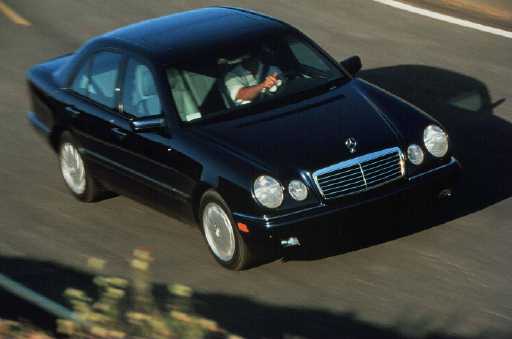New Car Review
1996 MERCEDES BENZ E320

SEE ALSO: Mercedes Buyer's Guide
by: CAREY and BILL RUSS
The new second-generation E-Class Mercedes-Benz is among the most important automobiles in the company's long history. Its immediate ancestor, introduced in 1985, was the company's worldwide sales leader and the most popular car in its class in the United States. There is nothing wrong with success, but times and conditions change. The past decade has seen serious competition in the heart of the luxury car market from the Japanese, and from other European and American marques as well.
Mercedes-Benz has been known as a manufacturer of fine luxury cars since its creation by a merger of the pioneering companies of Daimler and Benz in 1926. Meticulous craftsmanship, precision engineering, and conservative elegance are long-standing Mercedes-Benz characteristics. But the world changes. The characteristic conservative styling of Mercedes automobiles was not as attractive as possible for a new breed of younger luxury car buyer. The traditional, expensive construction techniques used by the company put them at a competitive disadvantage compared to some of the newcomers in the field. Changes in intent, design, and production were needed.
Changes were made. The introduction of the new C-class compact cars two years ago pointed to the future of Mercedes-Benz automobiles. A leaner, more efficient manufacturing process allowed the cars to be sold for less than their predecessors. The new E-Class benefits from the leaner production as well, with similar results for pricing. Unlike the evolutionarily-restyled C-Class, the redesign of the new E-Class car is quite revolutionary for Mercedes-Benz. It is indicative of major changes in the company. In many ways, the newest E-Class is the first Mercedes-Benz for the twenty- first century. The gasoline-powered E320 and the E300 Diesel are the first of the new E-Class cars available in America. Time spent driving on scenic highways and back roads and at the Willow Springs racetrack in Southern California showed the Mercedes-Benz E320 to be a wonderful car.
APPEARANCE: Nowhere is the revolutionary nature of the E320 more apparent than at the front of the car. Where older Mercedes-Benz models were Teutonically severe, the E320 is more aerodynamic, softer and friendlier. The traditional grille grows ever lower and wider, and is now flanked by four oval headlights. The rest of the car is much more rounded than its predecessor, but undeniably Mercedes-Benz in shape. The new E-Class is a masterful blend of tradition and innovation.
COMFORT: The increased size of the new E320 is more noticeable inside than outside. There is greater room in both the front and rear seats. As is appropriate for a luxury car, the interior of the E320 is outfitted in leather with walnut trim. The front bucket seats are power-adjustable with 3- position memory. The climate and sound system controls in the central console have been redesigned for easier use. A full complement of convenience features are standard equipment, including power- assisted door locks, mirrors, and windows, keyless remote entry with an anti-theft system, and universal garage door opener. A sunroof and integrated CD changer and cellular phone package are available. A remote trunk release and multiple cupholders show that the 1996 E320 is a German car designed with the American market in mind.
SAFETY: Many of the modern safety-related designs and construction methods were developed or first used in automobiles by Mercedes-Benz. Safety-cage construction with deformable crush zones, driver and passenger front air bags, antilock disc brakes, and traction control are on every E320, as are the world's first front door-mounted side airbags.
ROADABILITY: A new double-wishbone front suspension, power-assisted rack and pinion steering, a slightly longer wheelbase, and larger wheels and tires give the 1996 E320 excellent ride and handling characteristics. The car feels secure and comfortable on the interstate or a convoluted mountain road. The ride is firm but comfortable, with no trace of harshness. Wind, road, and mechanical noise are nearly nonexistent, making the E320 a great car for touring.
PERFORMANCE: The 3.2-liter, dual overhead cam, 24-valve inline six-cylinder engine in the E320 provides the smooth power that complements the car's ride and handling abilities. With 217 horsepower on tap to the rear wheels through a 4-speed automatic transmission, the E320 is quicker than many competitive luxury cars, quite fuel-efficient, and impeccably civilized.
CONCLUSIONS: The 1996 Mercedes-Benz heralds new directions and attitudes for one of the world's oldest and most respected automakers.
SPECIFICATIONS:
1996 MERCEDES BENZ E320
Base Price $ 43,500
Price As Tested $ 47,230
Engine Type inline 6, dohc, 24 valves
Horsepower 217 @ 5500
Torque (lb-ft) 229 @ 3750
Transmission 4-speed automatic
Wheelbase / Length 111.5 in. / 189.4 in.
Curb Weight 3,605 lbs.
Pounds Per Horsepower 16.6
Fuel Capacity 21.1 gal.
Fuel Requirement unleaded premium
Tires 215/55 HR16 Michelin MXV4
Brakes, front/rear vented disc / solid disc
Drivetrain front engine, rear drive
Suspension, front/rear independent with upper and lower control arms and
coil springs / independent multilink with coil springs
PERFORMANCE
EPA Fuel Economy - miles per gallon
city / highway / observed 19/26/22
0 to 60 mph 7.1 sec
1/4 mile (E.T.) 15.4 sec
Coefficient of Drag (cd) .29


